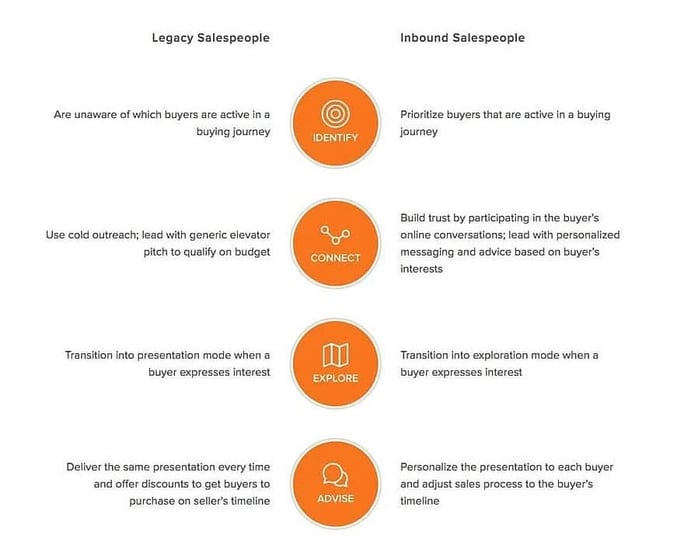It is well-versed that buyer behaviour has changed significantly in recent years. Inbound marketing redresses the balance by adapting to customers’ needs, but is Sales in danger of being left behind?
Changes in customer behaviour are widening the gap between buyers’ expectations and sellers’ tactics. HubSpot research shows there is a disconnect between customers’ expectations and traditional sales tactics. Buyers are not going to change, so the onus is on Sales to adapt.
The traditional sales process is broken
HubSpot’s “State of Inbound Report 2016” found that salespeople have become a last port of call for modern buyers. When buyers have a particular issue or point of pain to respond to they conduct their own research online - 62% of respondents use search and 48% visit a company’s website.
Only 29% of respondents say they want to speak with Sales during the Awareness stage of their research. Instead, buyers are reading blogs, social messages and content as they progress through and consider the options available to them.
Unsurprisingly, perhaps, the HubSpot report showed that 40% of salespeople say it’s getting harder to get a response from their prospects. However, when asked what their company's top priorities are for the coming year 70% prioritise “closing more deals”.
The Inbound Sales Approach
It is evident that Sales needs to find a new approach. Just as Inbound Marketing has eradicated pushy and interruptive outbound marketing methods: “Inbound Sales will transform sellers from aggressive closers into helpful advocates” (HubSpot research).
But what exactly is Inbound Sales and why does it fit so well with how today’s buyers makes purchases? HubSpot defines Inbound Sales as:
- Advisory - Inbound Sales' is focused on building trust from your buyers. Offer your prospects useful advice to help them make their decisions. A HubSpot mantra is: “Always be helpful”. Pete Caputa, writing for HubSpot, says: “The trick is to never let your prospect think you want the sale more than they need and want to buy from you.”
- Personalised – hand in hand with generating trust is an ability to connect with your buyer. If you’re a sales person, get to know who your buyers are and tailor your approach around their needs. Research potential prospects online. Use analytics tools to see what they look at on your website, or when are they open your emails. What are prospects talking about on social media? Identify trends and behaviour, which determine where the prospect is on their buyer's journey and over time you can tailor your content and generate better-qualified leads.
- Buyer-Centric - make the sales process focused on the buyer rather than the seller. Salespeople need to demonstrate they can add value by actively listening, find out what their prospects’ challenges and goals are and determine whether they are a good fit for your product or solution.
How Inbound Sales Compares to Traditional (Legacy) Sales Methods
Source: HubSpot Inbound Sales methodology
The Future of Sales
The State of Inbound report suggests the following top tips for making your sales process more inbound:
- Invest in social selling - 42% of buyers stated they use Twitter and LinkedIn for business, so you need to make sure your company is actively taking part - or get left behind.
- Overhaul the prospecting process - ensure your prospecting process aligns to what your buyers want and how they want to purchase.
- Stop cold calling - it no longer works.
- Commit to better Sales and Marketing alignment - Sales and Marketing must work closer than ever before, complimenting each other - not working against each other.
- Determine how your buyers want to communicate, and meet them where they are - HubSpot research identified email as the most preferred communication channel, but conduct your own research and prioritise whichever channel comes out top for your industry.
- Adopt CRM with an eye to integration capabilities - “In many organisations, CRM acts as the source of truth for prospect and customer interactions”. Integration between Sales and Marketing is virtually impossible without a robust CRM that works in conjunction with other business critical software solutions.
- Train your Sales Team - Sales is evolving and your team needs to keep up. Invest in training that will equip your Sales to serve the modern buyer - or someone else will; HubSpot research shows that sales people’s #1 priority when looking for a new job is an opportunity to grow.
As we discussed in a previous blog - read it here; more than ever, Sales and Marketing need to work together, sharing information and, ultimately, closing the loop so both gain actionable intelligence that helps improve outcomes from their efforts.



